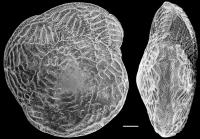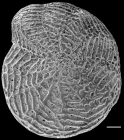Foraminifera taxon details
Notorotalia Finlay, 1939
465932 (urn:lsid:marinespecies.org:taxname:465932)
accepted
Genus
Notorotalia zelandica Finlay, 1939 (type by original designation)
- Species Notorotalia aparimae Hornibrook, 1996 †
- Species Notorotalia aucklandica Vella, 1957
- Species Notorotalia australis (Cushman, 1936)
- Species Notorotalia biconvexa Hornibrook, 1961 †
- Species Notorotalia bortonica Hornibrook, 1996 †
- Species Notorotalia braxtonensis Hornibrook, 1996 †
- Species Notorotalia briggsi Collen, 1972 †
- Species Notorotalia clathrata (Brady, 1884)
- Species Notorotalia crassimura Carter, 1958 †
- Species Notorotalia decurrens Chapman, 1941
- Species Notorotalia depressa Vella, 1957
- Species Notorotalia finlayi Vella, 1957
- Species Notorotalia hornibrooki Hayward, Grenfell, Reid & Hayward, 1999
- Species Notorotalia howchini (Chapman, Parr & Collins, 1934) †
- Species Notorotalia hurupiensis Vella, 1957 †
- Species Notorotalia inornata Vella, 1957
- Species Notorotalia kaiata Hornibrook, 1996 †
- Species Notorotalia kerguelenensis Parr, 1950
- Species Notorotalia kingmai Vella, 1957 †
- Species Notorotalia kiripakae Hornibrook, 1996 †
- Species Notorotalia kohaihae Hornibrook, 1996 †
- Species Notorotalia macinnesi Kennett, 1966 †
- Species Notorotalia macrostachei Hornibrook, 1996 †
- Species Notorotalia mammiligera Kennett, 1967 †
- Species Notorotalia mangaoparia Vella, 1957 †
- Species Notorotalia mesetachiquense Bertels, 1977 †
- Species Notorotalia olsoni Vella, 1957
- Species Notorotalia patagonica Parr, 1950
- Species Notorotalia pliozea Vella, 1957 †
- Species Notorotalia powelli Finlay, 1939 †
- Species Notorotalia praeserrata Hornibrook, 1996 †
- Species Notorotalia pristina Vella, 1957 †
- Species Notorotalia profunda Vella, 1957
- Species Notorotalia rotunda Vella, 1957 †
- Species Notorotalia ruatangatae Hornibrook, 1996 †
- Species Notorotalia serrata Finlay, 1939 †
- Species Notorotalia spinosa (Chapman, 1926) †
- Species Notorotalia stachei Finlay, 1939 †
- Species Notorotalia taranakia Vella, 1957 †
- Species Notorotalia targetensis Hornibrook, 1961 †
- Species Notorotalia uttleyi Hornibrook, 1961 †
- Species Notorotalia waitakiensis Hornibrook, 1992 †
- Species Notorotalia whaingaroica Hornibrook, 1996 †
- Species Notorotalia wilsoni Hornibrook, 1958 †
- Species Notorotalia zelandica Finlay, 1939
- Species Notorotalia aranea Hornibrook, 1958 † accepted as Discorotalia aranea (Hornibrook, 1958) †
- Species Notorotalia clarki Voloshinova, 1952 † accepted as Porosorotalia clarki (Voloshinova, 1952) † (Type species of Porosorotalia)
- Species Notorotalia kerguelensis Parr, 1950 accepted as Notorotalia kerguelenensis Parr, 1950 (unaccepted > misspelling - incorrect subsequent spelling, Incorrect subsequent spelling)
- Species Notorotalia millettii (Heron-Allen & Earland, 1915) accepted as Cristatavultus milletti (Heron-Allen & Earland, 1915) accepted as Elphidium milletti (Heron-Allen & Earland, 1915)
- Species Notorotalia tainuia Dorreen, 1948 † accepted as Cribrorotalia tainuia (Dorreen, 1948) † accepted as Porosorotalia tainuia (Dorreen, 1948) † (Type species of Cribrorotalia)
marine, brackish, fresh, terrestrial
recent + fossil
feminine
Finlay, H. J. (1939). New Zealand Foraminifera: Key Species in Stratigraphy - No. 1. <em>Transactions of the Royal Society of New Zealand.</em> 68: 504-533., available online at http://rsnz.natlib.govt.nz/volume/rsnz_68/rsnz_68_04_003710.html
page(s): p. 517 [details] Available for editors [request]
[request]
page(s): p. 517 [details] Available for editors
Diagnosis Test lenticular, trochospirally coiled, about eleven chambers in the final whorl, umbonal region with overlapping platelike...
Diagnosis Test lenticular, trochospirally coiled, about eleven chambers in the final whorl, umbonal region with overlapping platelike extensions of the chambers, retral processes present but only observable at the interior as there are no hollow ponticuli, sutures curved, elevated, each with a double row of pores with slightly elevated rim, but these are not homologous with the fossettes of Elphidium, central umbilical region has a distinct spiral canal system formed by sealing off the umbilicalmost part of the chamber lumen as in Elphidiella, the posterior umbilical aperture then connects the spiral canal to the subsutural canals that also are formed as in Elphidiella, periphery sharply angular; wall calcareous, perforate, lamellar, optically radial, septa bilamellar with added septal flap, surface with spiralling ridges parallel to the peripheral margin, apertural face with radiating ridges, and with surface between ridges densely covered with fine tubercles; aperture and foramina consist of a row of openings with bordering rims situated in deep clefts between the ridges near the base of the apertural face, openings may be somewhat obscured by the ridges and tubercles. M. Eocene to Holocene; New Zealand; Eastern Australia; Sub-Antarctic; Kerguelen Island; Falkland Islands; Argentina; Uruguay. (Loeblich & Tappan, 1987, Foraminiferal Genera and Their Classification) [details]
Hayward, B.W.; Le Coze, F.; Vachard, D.; Gross, O. (2021). World Foraminifera Database. Notorotalia Finlay, 1939. Accessed at: http://www.marinespecies.org/foraminifera/aphia.php?p=taxdetails&id=465932 on 2025-05-12
Date
action
by
original description
Finlay, H. J. (1939). New Zealand Foraminifera: Key Species in Stratigraphy - No. 1. <em>Transactions of the Royal Society of New Zealand.</em> 68: 504-533., available online at http://rsnz.natlib.govt.nz/volume/rsnz_68/rsnz_68_04_003710.html
page(s): p. 517 [details] Available for editors [request]
[request]
basis of record Hayward, B. W.; Grenfell, H. R.; Reid, C. M.; Hayward, K. A. (1999). Recent New Zealand shallow-water benthic Foraminifera: Taxonomy, ecologic distribution, biogeography, and use in paleoenvironmental assessment. <em>Institute of Geological and Nuclear Sciences Monograph.</em> 21: 1-258., available online at https://www.researchgate.net/publication/256455698 [details] Available for editors [request]
[request]
additional source Loeblich, A. R.; Tappan, H. (1987). Foraminiferal Genera and their Classification. Van Nostrand Reinhold Company, New York. 970pp., available online at https://books.google.pt/books?id=n_BqCQAAQBAJ [details] Available for editors [request]
[request]
page(s): p. 517 [details] Available for editors
basis of record Hayward, B. W.; Grenfell, H. R.; Reid, C. M.; Hayward, K. A. (1999). Recent New Zealand shallow-water benthic Foraminifera: Taxonomy, ecologic distribution, biogeography, and use in paleoenvironmental assessment. <em>Institute of Geological and Nuclear Sciences Monograph.</em> 21: 1-258., available online at https://www.researchgate.net/publication/256455698 [details] Available for editors
additional source Loeblich, A. R.; Tappan, H. (1987). Foraminiferal Genera and their Classification. Van Nostrand Reinhold Company, New York. 970pp., available online at https://books.google.pt/books?id=n_BqCQAAQBAJ [details] Available for editors
 Present
Present  Inaccurate
Inaccurate  Introduced: alien
Introduced: alien  Containing type locality
Containing type locality
From editor or global species database
Diagnosis Test lenticular, trochospirally coiled, about eleven chambers in the final whorl, umbonal region with overlapping platelike extensions of the chambers, retral processes present but only observable at the interior as there are no hollow ponticuli, sutures curved, elevated, each with a double row of pores with slightly elevated rim, but these are not homologous with the fossettes of Elphidium, central umbilical region has a distinct spiral canal system formed by sealing off the umbilicalmost part of the chamber lumen as in Elphidiella, the posterior umbilical aperture then connects the spiral canal to the subsutural canals that also are formed as in Elphidiella, periphery sharply angular; wall calcareous, perforate, lamellar, optically radial, septa bilamellar with added septal flap, surface with spiralling ridges parallel to the peripheral margin, apertural face with radiating ridges, and with surface between ridges densely covered with fine tubercles; aperture and foramina consist of a row of openings with bordering rims situated in deep clefts between the ridges near the base of the apertural face, openings may be somewhat obscured by the ridges and tubercles. M. Eocene to Holocene; New Zealand; Eastern Australia; Sub-Antarctic; Kerguelen Island; Falkland Islands; Argentina; Uruguay. (Loeblich & Tappan, 1987, Foraminiferal Genera and Their Classification) [details]










